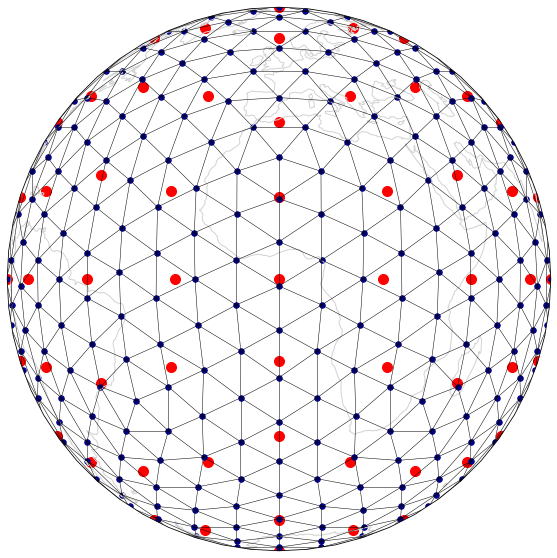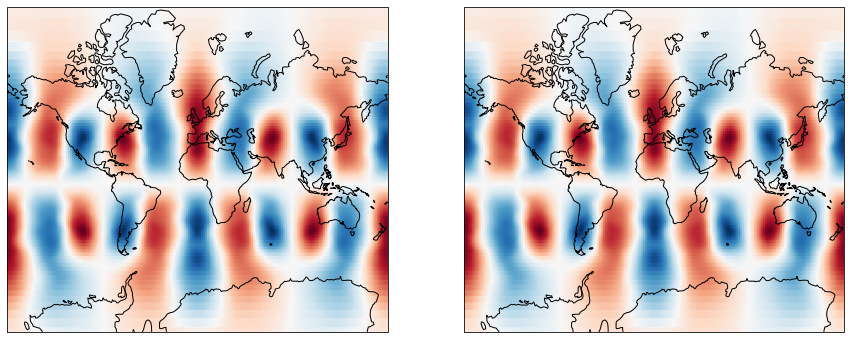Example 3 - stripy interpolation on the sphere
Contents
Example 3 - stripy interpolation on the sphere¶
SSRFPACK is a Fortran 77 software package that constructs a smooth interpolatory or approximating surface to data values associated with arbitrarily distributed points on the surface of a sphere. It employs automatically selected tension factors to preserve shape properties of the data and avoid overshoot and undershoot associated with steep gradients.
The next three examples demonstrate the interface to SSRFPACK provided through stripy
Notebook contents¶
The next example is Ex4-Gradients
Define two different meshes¶
Create a fine and a coarse mesh without common points
import stripy as stripy
cmesh = stripy.spherical_meshes.triangulated_cube_mesh(refinement_levels=2)
fmesh = stripy.spherical_meshes.icosahedral_mesh(refinement_levels=2, include_face_points=True)
print(cmesh.npoints)
print(fmesh.npoints)
98
482
help(cmesh.interpolate)
Help on method interpolate in module stripy.spherical:
interpolate(lons, lats, zdata, order=1, grad=None, sigma=None) method of stripy.spherical_meshes.triangulated_cube_mesh instance
Base class to handle nearest neighbour, linear, and cubic interpolation.
Given a triangulation of a set of nodes on the unit sphere, along with data
values at the nodes, this method interpolates (or extrapolates) the value
at a given longitude and latitude.
Args:
lons : float / array of floats, shape (l,)
longitudinal coordinate(s) on the sphere
lats : float / array of floats, shape (l,)
latitudinal coordinate(s) on the sphere
zdata : array of floats, shape (n,)
value at each point in the triangulation
must be the same size of the mesh
order : int (default=1)
order of the interpolatory function used
- `order=0` = nearest-neighbour
- `order=1` = linear
- `order=3` = cubic
sigma : array of floats, shape (6n-12)
precomputed array of spline tension factors from
`get_spline_tension_factors(zdata, tol=1e-3, grad=None)`
(only used in cubic interpolation)
Returns:
zi : float / array of floats, shape (l,)
interpolated value(s) at (lons, lats)
err : int / array of ints, shape (l,)
whether interpolation (0), extrapolation (1) or error (other)
%matplotlib inline
import cartopy
import cartopy.crs as ccrs
import matplotlib.pyplot as plt
import numpy as np
def mesh_fig(mesh, meshR, name):
fig = plt.figure(figsize=(10, 10), facecolor="none")
ax = plt.subplot(111, projection=ccrs.Orthographic(central_longitude=0.0, central_latitude=0.0, globe=None))
ax.coastlines(color="lightgrey")
ax.set_global()
generator = mesh
refined = meshR
lons0 = np.degrees(generator.lons)
lats0 = np.degrees(generator.lats)
lonsR = np.degrees(refined.lons)
latsR = np.degrees(refined.lats)
lst = generator.lst
lptr = generator.lptr
ax.scatter(lons0, lats0, color="Red",
marker="o", s=100.0, transform=ccrs.PlateCarree())
ax.scatter(lonsR, latsR, color="DarkBlue",
marker="o", s=30.0, transform=ccrs.PlateCarree())
segs = refined.identify_segments()
for s1, s2 in segs:
ax.plot( [lonsR[s1], lonsR[s2]],
[latsR[s1], latsR[s2]],
linewidth=0.5, color="black", transform=ccrs.Geodetic())
# fig.savefig(name, dpi=250, transparent=True)
return
mesh_fig(cmesh, fmesh, "Two grids" )

Analytic function¶
Define a relatively smooth function that we can interpolate from the coarse mesh to the fine mesh and analyse
def analytic(lons, lats, k1, k2):
return np.cos(k1*lons) * np.sin(k2*lats)
coarse_afn = analytic(cmesh.lons, cmesh.lats, 5.0, 2.0)
fine_afn = analytic(fmesh.lons, fmesh.lats, 5.0, 2.0)
The analytic function on the different samplings¶
It is helpful to be able to view a mesh in 3D to verify that it is an appropriate choice. Here, for example, is the icosahedron with additional points in the centroid of the faces.
This produces triangles with a narrow area distribution. In three dimensions it is easy to see the origin of the size variations.
import k3d
plot = k3d.plot(camera_auto_fit=False, grid_visible=False,
menu_visibility=False, axes_helper=False )
findices = fmesh.simplices.astype(np.uint32)
cindices = cmesh.simplices.astype(np.uint32)
fpoints = np.column_stack(fmesh.points.T).astype(np.float32)
cpoints = np.column_stack(cmesh.points.T).astype(np.float32)
plot += k3d.mesh(fpoints, findices, wireframe=False, color=0xBBBBBB,
flat_shading=True, opacity=1.0 )
plot += k3d.points(fpoints, point_size=0.01,color=0xFF0000)
plot += k3d.points(cpoints, point_size=0.02,color=0x00FF00)
plot.display()
Interpolation from coarse to fine¶
The interpolate method of the sTriangulation takes arrays of longitude, latitude points (in radians) and an array of
data on the mesh vertices. It returns an array of interpolated values and a status array that states whether each value
represents an interpolation, extrapolation or neither (an error condition). The interpolation can be nearest-neighbour (order=0),
linear (order=1) or cubic spline (order=3).
interp_c2f1, err = cmesh.interpolate(fmesh.lons, fmesh.lats, order=1, zdata=coarse_afn)
interp_c2f3, err = cmesh.interpolate(fmesh.lons, fmesh.lats, order=3, zdata=coarse_afn)
err_c2f1 = interp_c2f1-fine_afn
err_c2f3 = interp_c2f3-fine_afn
interp_c2f1.max()
0.9118629302784802
import k3d
plot = k3d.plot(camera_auto_fit=False, grid_visible=False,
menu_visibility=True, axes_helper=False )
findices = fmesh.simplices.astype(np.uint32)
cindices = cmesh.simplices.astype(np.uint32)
fpoints = np.column_stack(fmesh.points.T).astype(np.float32)
cpoints = np.column_stack(cmesh.points.T).astype(np.float32)
plot += k3d.mesh(fpoints, findices, wireframe=False, attribute=interp_c2f1,
color_map=k3d.colormaps.basic_color_maps.CoolWarm,
name="1st order interpolant",
flat_shading=False, opacity=1.0 )
plot += k3d.mesh(fpoints, findices, wireframe=False, attribute=interp_c2f3,
color_map=k3d.colormaps.basic_color_maps.CoolWarm,
name="3rd order interpolant",
flat_shading=False, opacity=1.0 )
plot += k3d.mesh(fpoints, findices, wireframe=False, attribute=err_c2f1,
color_map=k3d.colormaps.basic_color_maps.CoolWarm,
name="1st order error",
flat_shading=False, opacity=1.0 )
plot += k3d.mesh(fpoints, findices, wireframe=False, attribute=err_c2f3,
color_map=k3d.colormaps.basic_color_maps.CoolWarm,
name="3rd order error",
flat_shading=False, opacity=1.0 )
plot += k3d.points(fpoints, point_size=0.01,color=0x779977)
plot.display()
Interpolate to grid¶
Interpolating to a grid is useful for exporting maps of a region. The interpolate_to_grid method interpolates mesh data to a regular grid defined by the user. Values outside the convex hull are extrapolated.
interpolate_to_gridis a convenience function that yields identical results to interpolating over a meshed grid using theinterpolatemethod.
resX = 200
resY = 100
extent_globe = np.radians([-180,180,-90,90])
grid_lon = np.linspace(extent_globe[0], extent_globe[1], resX)
grid_lat = np.linspace(extent_globe[2], extent_globe[3], resY)
grid_z1 = fmesh.interpolate_to_grid(grid_lon, grid_lat, interp_c2f3)
# compare with `interpolate` method
grid_loncoords, grid_latcoords = np.meshgrid(grid_lon, grid_lat)
grid_z2, ierr = fmesh.interpolate(grid_loncoords.ravel(), grid_latcoords.ravel(), interp_c2f3, order=3)
grid_z2 = grid_z2.reshape(resY,resX)
fig = plt.figure(figsize=(15, 10), facecolor="none")
ax1 = plt.subplot(121, projection=ccrs.Mercator())
ax1.coastlines()
ax1.set_global()
ax1.imshow(grid_z1, extent=np.degrees(extent_globe), cmap='RdBu', transform=ccrs.PlateCarree())
ax2 = plt.subplot(122, projection=ccrs.Mercator())
ax2.coastlines()
ax2.set_global()
ax2.imshow(grid_z2, extent=np.degrees(extent_globe), cmap='RdBu', transform=ccrs.PlateCarree())
<matplotlib.image.AxesImage at 0x7f8f3027c2d0>

The next example is Ex4-Gradients